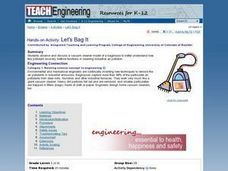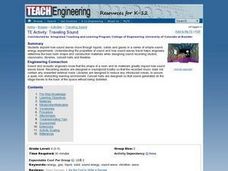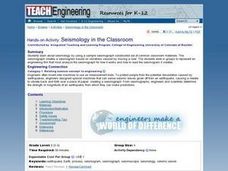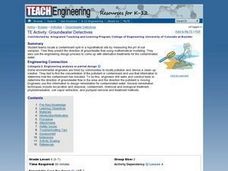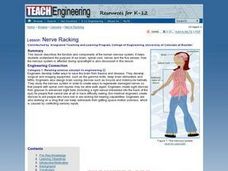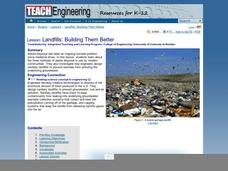Curated OER
Let's Bag It
Young scholars observe and discuss a vacuum cleaner model of a baghouse to better understand how this pollutant recovery method functions in cleaning industrial air pollution. They give examples of when the use of a baghouse is...
Curated OER
Fuel Mystery Dis-Solved
Students describe how temperature and surface area exposure affect the rate at which fuel is consumed. They explain why engineers want to know about the properties of a fuel when designing rockets. They create a bar graph of result data.
Curated OER
Traveling Sound
Students explore how sound waves move through liquids, solids and gases in a series of simple sound energy experiments. They describe how sound needs molecules to move and that changing the medium that it travels through changes the...
Curated OER
Turbojet Thrust
Students, after reading the Web page Turbojet Thrust and completing the activity, explain how jet engines use air to produce thrust. The educational software ""FoilSim" is used in this lesson to help students calculate thrust.
Curated OER
Naturally Speaking
Students identify the Earth's natural resources and classify them as renewable or non-renewable. They simulate the distribution of resources and discuss the fairness and effectiveness of the distribution. They identify ways that they use...
Curated OER
Seismology in the Classroom
Students work together to use a sample seismograph. They role play the position of an engineering firm that is to analyze the machine. They discover how engineers develop new machines to take measurements.
Curated OER
Learn to Build a Rocket in 5 Days or Your Money Back
Students discover the entire process that goes into designing a rocket for any customer. They study important factors such as supplies, ethics, deadlines and budgets. Also, students explore about the Engineering process, and recognize...
Curated OER
Groundwater Detectives
Students measure the pH of soil samples from a hypothetical site to locate a contaminant spill and will predict the direction of groundwater flow using mathematical modeling. They use the engineering design process to develop...
Curated OER
Nerve Racking
Fifth graders study the components and function of the nervous system. They investigate how engineers design biomedical equipment to assist the nervous system and explain how the five senses are affected during spaceflight.
Curated OER
GPS Scavenger Hunt
Students go on a GPS scavenger hunt. They use GPS receivers to find designated waypoints and report back on what they found. They compute distances between waypoints based on the latitude and longitude, and compare with the distance the...
Curated OER
Cruising the Internet
Students identify the parts of an engine using a graph. In this statistics lesson, students make a graph from their collected data. They calculate the volume of a cylinder using a line of regression and a scatter plot.
Curated OER
TE Activity: Stream Consciousness
Fourth graders study how environmental engineers monitor water quality. They use environmental indicators to determine the quality of stream water in their area. They count the number of macroinverabrates and use the information they...
Curated OER
Tenochtitlan Needs a Drink
Students engineer a way to provide drinking water using Aztec technology. For this engineering a way to provide drinking water using Aztec technology lesson, students find a way to deliver fresh water to a city surrounded by salt...
Curated OER
Building Straw Towers
Students apply their knowledge of technology to help them build. In this science and technology lesson, students build straw towers and investigate the strength and form of the structure. They analyze the best design the make the...
Curated OER
Unlocking the Endocrine System
Fifth graders use an analogy to the mail delivery system to study the workings of the human endocrine system. They discover the interrelationships between the human body systems while comparing them to engineering communicating with...
Curated OER
What is Energy?
Students define energy and identify the different types that exist. They identify places they see, hear or feel energy. They understand the role of engineering in finding and testing sources of energy for the production of electricity.
Curated OER
Acid Attack
Students explore the effect of chemical erosion on statues and monuments. They use chalk to see what happens when limestone is placed in liquids with different pH values. They also discover several things that engineers are doing to...
Curated OER
TE Activity: Choosing a Pyramid Site
Students determine how engineers decide on choices for final designs and sites for construction. They look at a surveyor's report while they evaluate sites where a pyramid could be build. They consider the distance the pyramid would be...
Curated OER
TE Activity: Pitch and Frequency
Students experiment with a vibrating ruler and a kazoo to study the different pitches and frequencies they produce. They create both high and low pitch sound waves. They examine how engineers use sound energy when designing electronic...
Curated OER
Landfills: Building Them Better
Students investigate the three methods of waste disposal. They listen to a teacher-led lecture, answer discussion questions, and write a letter to the E.P.A. from the viewpoint of an environmental engineer.
Curated OER
Catapults!
Students work together to discover the relationship between the angle of catapults and the flight of different objects. They discover the heavier the object the more force is needed. They examine how engineers use this information to...
Curated OER
Computer Accuracy
Middle schoolers work together on computers to practice measuring for navigation. They discover that errors in their calculations can lead them in the wrong direction. They examine the need of computers by engineers.
Curated OER
Magnitude of the Richter Scale
Students examine how a Richter scale operates. They create a booklet illustrating each rating on the scale. They discover how engineers use different measurement tools.
Curated OER
Solar Power
Pupils discover how engineers use solar energy to heat buildings. They investigate the thermal properties of different materials. They evaluate the usefulness of each material.


